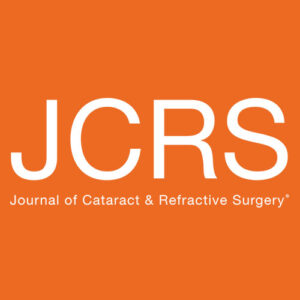ASCRS News: EyeWorld Journal Club
July 2023
by Christopher Long, MD, Shaunak Bakshi, MD, Ian Christensen, MD, Abinaya Thenappan, MD, Austin Bohner, MD*
University of Southern California/Los Angeles General Medical Center Ophthalmology Residents
*All authors contributed equally to this work

In-the-bag (ITB) dislocations of an intraocular lens (IOL) after cataract surgery is a rare complication that can detract from the many benefits of cataract surgery. ITB dislocation refers specifically to dislocation of the entire capsule-IOL complex, usually a late (months to years) complication that occurs as a result of zonular weakness induced by anterior capsule contraction.1,2 Capsular tension rings (CTRs) have been shown to stabilize the capsule intraoperatively in the setting of zonular dehiscence or instability.3,4 Logically, CTR implantation has been hypothesized as a potential method to reduce the incidence of ITB dislocations. Previous research, however, has been inconclusive. While some studies support the protective effects of CTRs, others suggest CTRs may lead to earlier and more frequent ITB dislocations.2,5,6,7 Therefore, Mayer-Xanthaki et al. sought to further characterize the impact of CTR implantation on the development of ITB dislocations.
Methods
This investigation was conducted as a single- center, retrospective cohort study based on medical records at the Medical University of Graz, a tertiary care center in Austria. These data had previously been utilized by some of the authors in a study on the relationship between IOL design and ITB dislocation.8 The study included patients who received cataract surgery, including extracapsular cataract extraction and phacoemulsification with implantation of a posterior chamber IOL, from July 1996 to July 2017, with identification of postoperative referrals due to IOL dislocations in this time period. ITB dislocation of interest in this study was defined as IOL-capsular bag complex luxation after uncomplicated cataract surgery and IOL implantation. The extracted dataset comprised variables including sex, age, technique of cataract surgery, the operated eye, zonular fiber weakness in surgery, non-sutured CTR insertion during surgery, anterior capsule staining with trypan blue, and noted time to IOL dislocation. Previously reported possible risk factors for IOL dislocation, including pseudoexfoliation (PEX), axial length ≥25.5 mm, uveitis, ocular trauma, and retinitis pigmentosa, were also identified. Cases of intracapsular extraction, intraoperative posterior capsular rupture, combined phacoemulsification and vitrectomy, and IOL dislocations referred from other institutions were excluded. Descriptive statistics included medians and range for the metric variables, and absolute and relative frequencies for the categorical variables. Exploratory univariate and multivariate Cox proportional hazards regression analyses were employed for risk factors and hazard ratios (with determination of 95% confidence intervals), with follow-up time defined as last follow-up noted in the record, date of presentation with IOL dislocation, or estimated life expectancy from the time of surgery (determined based on annual Austrian national census data). The statistical significance threshold was set at a P value of 0.05.

Source: Keck School of Medicine of USC
Results
A total of 68,199 eyes were included in the analysis. Median age at the time of surgery was 76 years. 60.2% of the surgeries were performed in women. Phacoemulsification was performed in 65,143 (95.5%) eyes and extracapsular cataract extraction with manual extraction of the nucleus in 3,056 (4.5%) eyes. One hundred and eleven (0.16%) ITB dislocations were registered. The median number of years between the cataract surgery and the ITB dislocation was 6.8 (range 0.1 to 18.8). For dislocations with and without a CTR, the median number of years was 4.3 (0.4 to 14.9) and 7.0 (0.1 to 18.8), respectively. In the univariable Cox regression analysis and multivariate model, CTR, PEX, weak zonular fibers, uveitis, retinitis pigmentosa young age, and male sex were significantly associated with an ITB dislocation. Large overall IOL diameter was a protective factor according to the multivariate model. One hundred thirty- one eyes of 4,999 eyes with PEX had a CTR implanted. A subgroup analysis showed reduced risk of ITB dislocation for CTR use in eyes with PEX (HR, 0.16, 95% CI, 0.04–0.70; P=0.015). Of 1,103 eyes with weak zonular fibers, 542 had a CTR implantation. Using a CTR in eyes with zonular weakness offered only a potential risk reduction (HR, 0.37, 95% CI, 0.12–1.12; P=0.078).
While some studies support the protective effects of CTRs, others suggest CTRs may lead to earlier and more frequent ITB dislocations. Therefore, Mayer-Xanthaki et al. sought to further characterize the impact of CTR implantation on the development of ITB dislocations.
Discussion
Mayer-Xanthaki et al. found that CTR implantation was associated with a lower risk of late ITB dislocation. Due to the high prevalence of PEX and its known association as a predisposing risk factor, a subgroup analysis for patients with PEX was performed. This subgroup analysis demonstrated CTR implantation was protective against ITB dislocation in eyes with PEX but not for eyes without PEX. CTR implantation was also found to lower the risk of anterior capsule contraction syndrome, decentration of the entire capsular bag, and PCO. The authors calculated 73 eyes with PEX as the number needed to treat to prevent one late ITB dislocation.
In another subgroup analysis, though not statistically significant, CTR implantation in eyes with zonular weakness lowered the risk of ITB dislocation. The lack of statistical significance may be due to the subjective nature of diagnosing zonular weakness and the fact that documenting zonular instability was optional by the authors’ protocol, which could have resulted in underreporting. Based on the results, the authors suggested taking caution in cases with zonular weakness and considering implanting a CTR if deemed appropriate by the surgeon.
Consistent with similar prior studies, Mayer-Xanthaki et al. demonstrated CTR implantation reduced the time between cataract surgery and ITB dislocation. No clear pathophysiology has been established for this finding; however, the authors proposed selection bias toward a CTR in eyes with zonular weakness and incorrect haptic CTR interaction as possible causes.
Overall, this study was robust due to its large sample size and 21-year follow-up period. However, CTR implantation was identified by operative reports and thus may have been underestimated. Also, the authors do not have information as to when the CTR implantation took place intraoperatively. Placing the CTR before phacoemulsification may reduce zonular damage, whereas placing it after could strain the zonular fibers during cortex removal.
Capsular tension ring as protective measure against in-the-bag dislocations after cataract surgery
Mayer-Xanthaki CF, et al. J Cataract Refract Surg. 2023;49:154–158
- Purpose: To assess the influence of capsular tension ring (CTR) implantation on the development of in-the-bag (ITB) dislocations after cataract surgery.
- Setting: Department of Ophthalmology Graz, Graz, Austria, Europe.
- Design: Single centre, retrospective cohort study.
- Methods: The medical records of patients who underwent cataract operation between 1996 and 2017 were analysed. Cox proportional hazards regression analysis was used to assess the influence of CTR implantation and other predisposing factors (pseudoexfoliation [PEX], age, retinitis pigmentosa, gender, zonular weakness, uveitis, high myopia, and intraocular lens design and material) on ITB dislocations.
- Results: We found ITB dislocations in 111 (0.16%) out of 68,199 eyes (46,632 patients). In the multivariable analysis adjusted for other predisposing risk factors, a CTR implantation was associated with a lower risk of an ITB dislocation (hazard ratio [HR] 0.29; 95% confidence interval (CI), 0.11–0.80; p=0.017). In eyes with PEX, a CTR implantation was associated with an HR of 0.16 (95% CI, 0.04–0.70; p=0.015), whereas eyes without PEX had an HR of 0.80 (95% CI, 0.14–4.41; p=0.793). A CTR implantation in eyes with zonular weakness resulted in a potentially lower risk (HR 0.37; 95% CI, 0.12–1.12; p=0.078).
- Conclusion: According to our data set, implantation of a CTR was a protective measure against an ITB dislocation. Especially in patients with zonular weakness and PEX, the CTR implantation was associated with a lower risk of ITB dislocations. In patients without PEX, no association was established.
References
- Mamalis N. Intraocular lens dislocation. J Cataract Refract Surg. 2013;39:973–974.
- Gimbel HV, et al. Late in-the-bag intraocular lens dislocation: incidence, prevention, and management. J Cataract Refract Surg. 2005;31:2193–2204.
- Georgopoulos GT, et al. Management of large traumatic zonular dialysis with phacoemulsification and IOL implantation using the capsular tension ring. Acta Ophthalmol Scand. 2007;85:653–657.
- Wang BZ, et al. A retrospective study of the indications and outcomes of capsular tension ring insertion during cataract surgery at a tertiary teaching hospital. Clin Ophthalmol. 2013;7:567–572.
- Lorente R, et al. Management of late spontaneous in-the-bag intraocular lens dislocation: retrospective analysis of 45 cases. J Cataract Refract Surg. 2010;36:1270–1282.
- Werner L, et al. In-the-bag capsular tension ring and intraocular lens subluxation or dislocation: a series of 23 cases. Ophthalmology. 2012;119:266–271.
- Artzen D, et al. Visual acuity and intraocular pressure after surgical management of late in-the-bag dislocation of intraocular lenses. A single-centre prospective study. Eye (Lond). 2020;34:1406–1412.
- Mayer-Xanthaki CF, et al. Impact of intraocular lens characteristics on intraocular lens dislocation after cataract surgery. Br J Ophthalmol. 2021;105:1510–1514.
Contact
Bakshi: shaunak.bakshi@med.usc.edu
Bohner: adbohner@gmail.com
Christensen: iantchristensen@gmail.com
Long: chrisplong7@gmail.com
Song: Brian.Song@med.usc.edu
Thenappan: aat2164@columbia.edu



